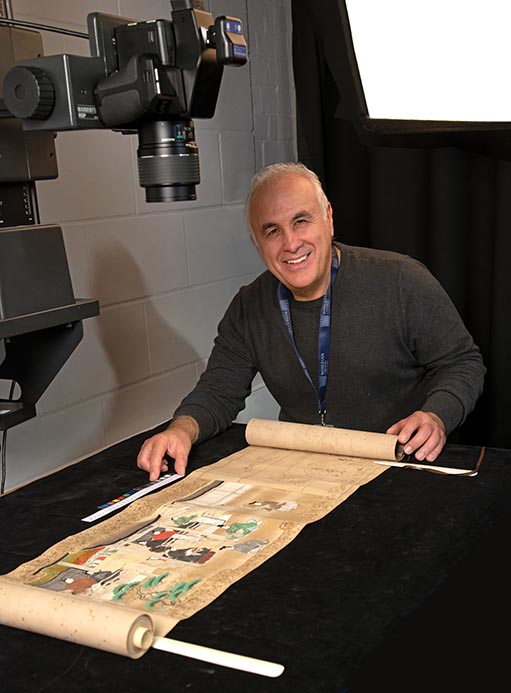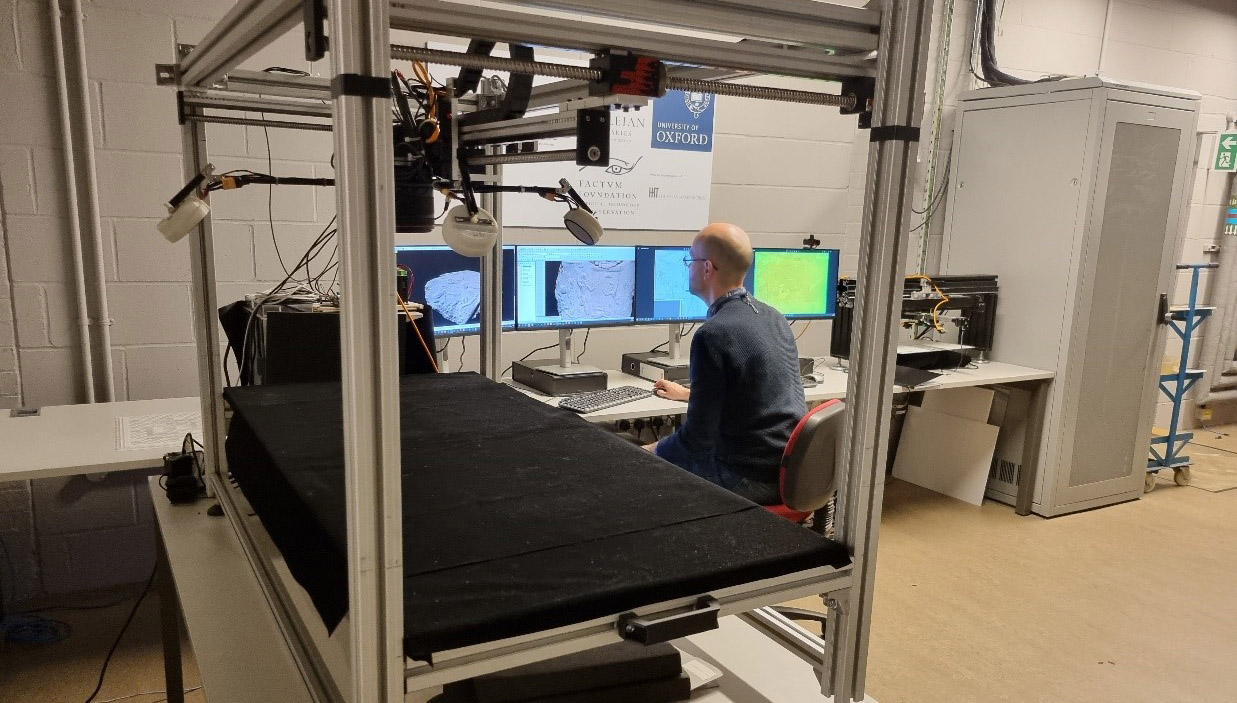Our work in Imaging Services
How we work

David Belcher, Photographer, using the conservation cradle to digitise a whole volume. (Image © Bodleian Libraries, University of Oxford)
The imaging work of ‘taking pictures’ of the Bodleian Libraries special collections, leaf by leaf, is at the core of what the Imaging Studio do. But we are only part of the story. The videos below show how this work fits in to the final product being available to all on Digital Bodleian.
Who we work with
Some of our work is with funders and other agencies who are targeting specific areas of study and some is led by the curators. We work with colleges and departments within the University of Oxford as well as doing work for places such as the History of Science Museum in Oxford.
We digitise maps to palm leaf fragments, books to letters, gold leaf to inscribed parchment and objects. Anything from the First Folio of Shakespeare’s works (Arch. G c.7) to an Oxford University Association Football Club minute record book, 1871 to 1883 (MS. 22360/1).
Occasionally we have the opportunity to get out of the studio to record the exhibitions and public engagement events organised by teams at the Bodleian Libraries.
What we do
Below are just some of the projects undertaken by the Imaging Services team.

Giorgio Garippa (Photographer) working on the flat copy station to record a book from the Chinese collections. (Image © Bodleian Libraries, University of Oxford)

Jess Chaundy (Photographer) using ultra violet light set up on one of the flat copy stations to capture a paper watermark for a customer order. (Image © Bodleian Libraries, University of Oxford)

Ellie Harris (Photographer) working on one of the Guardian stations capturing 18th and 19th century dissertations (Image © Bodleian Libraries, University of Oxford).

Nick Cistone (Chief Photographer) working on one of the flat copy stations capturing Japanese and Chinese scrolls. These are captured in sections and then ‘stitched’ together to create a single image. (Image © Bodleian Libraries, University of Oxford)

Nick Emm (Senior Photographer) working with the Bodleian’s Retail and Communications Team in the Delegates Room at the Clarendon building to produce web banners for Christmas 2024.
Ongoing adventures in digital imaging and research: ARCHiOx

John Barrett, Imaging Specialist for ARCHiOx and the prototype ‘Selene’ used for recording the low relief items. (Image © Bodleian Libraries, University of Oxford)
In 2022 we began the first phase of the ARCHiOx (Analysis and Recording of Cultural Heritage in Oxford) initiative to develop new 'technology' for the recording of low-relief items in 'three' dimensions and the analysis of these outputs. In only 12 months, the Bodleian Libraries and the Factum Foundation established a highly effective partnership that enabled us to quickly develop new approaches to the imaging of collections held by the Libraries. This activity has had profound impacts for library staff and for researchers within and beyond Oxford, and garnered significant national press interest.
In 2023 a second phase of the project saw the development of a ‘mobile’ Selene by the Factum Foundation and improvements to workflows/software. The Bodleian Libraries team at BDLSS created a ‘viewer’ so that images produced by ARCHiOx using the Selene can be accessed through Digital Bodleian. There have been more ‘discoveries’ from within the libraries collections.
With effect from October 2024 ‘ARCHiOx’ is an embedded service within the Imaging Services department offering photometric stereo and photogrammetry services.
The ARCHiOx project was initiated, nurtured and funded by the Helen Hamlyn Trust, and the Bodleian Libraries and Factum Foundation are deeply grateful for this support.
Recordings and press releases
Read our press release about the project: The ARCHiOx Project: Seeing the Unseen in Bodleian Collections
Read blogposts from our The Conveyor blog:
- Women in the Margins: Eadburg and Bodleian Library, MS. Selden Supra 30
- Researching and Digitising Copper Printing Plates at the Bodleian Library
Watch a video of a session exploring some of the project's findings: ARCHiOX – Seeing the Unseen in Bodleian Collections
Press coverage
- BBC Future: The mysterious doodles hidden in a 1,300-year-old book
- New Scientist: Gough Map: How new technology uncovered secrets of rare Bodleian artefact (YouTube)
- William Blake copper plate doodles:
- The Art Newspaper and Fine Books Magazine published stories on the discovery of the William Blake doodles
- BBC Radio 4’s Today Programme spoke with Mark Crosby, researcher, on 23 October 2024 (1:44 mark).
- The Times (Jack Blackburn) covered the discovery including an interview with Mark Crosby online and in print


